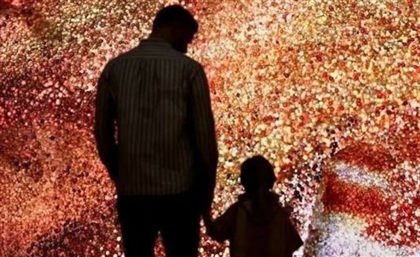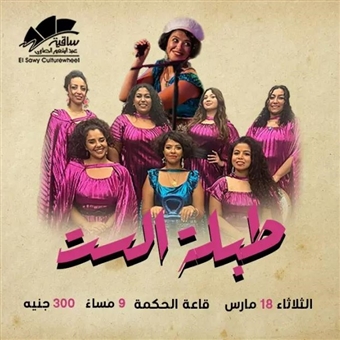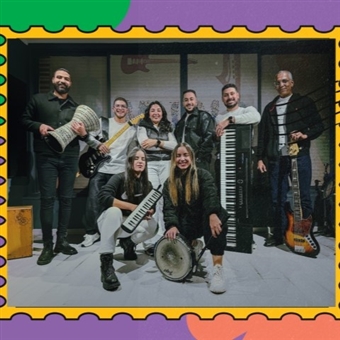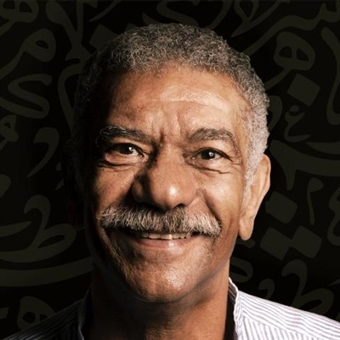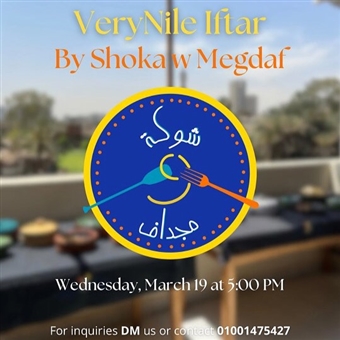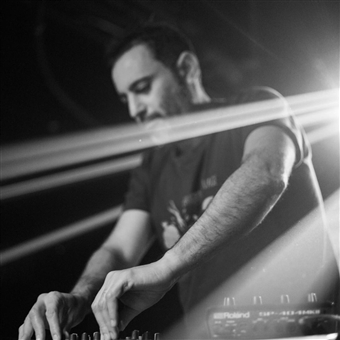Absolut Warhol Art Exchange: Moe Asem X Hanan Ghanem
For the final one of our series of Andy-Warhol-inspired Art Exchange talks, we bring together two local artists and let them interview each other over a few Absolut cocktails...
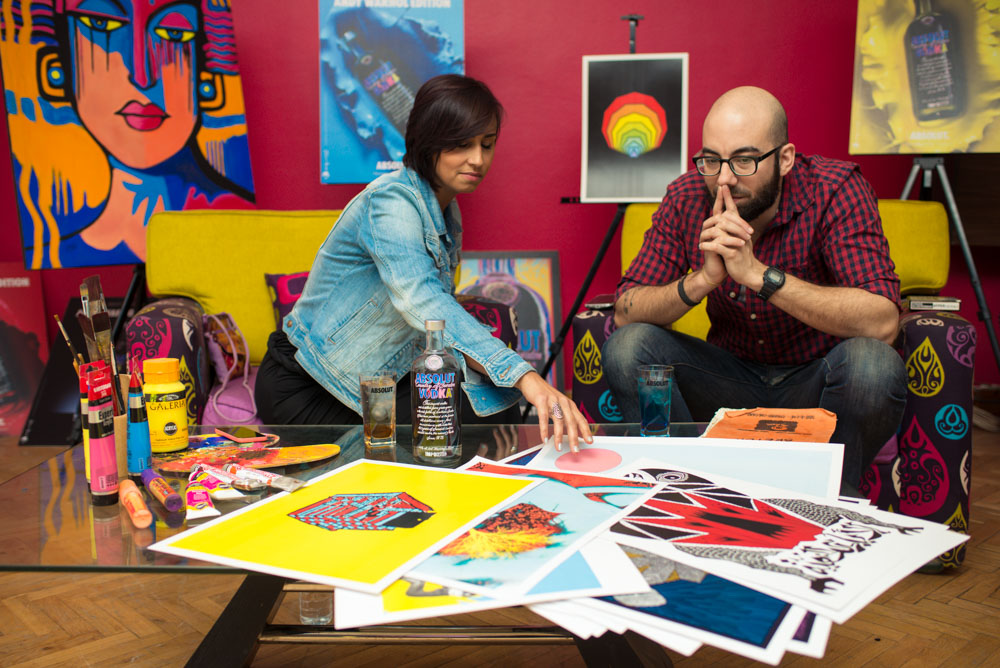
In the last of our series of creative conversations inspired by the launch of the Andy Warhol edition Absolut bottle, distributed worldwide, we bring together graphic artist Mohamed ‘Moe’ Asem with painter Hanan Ghanem over a couple of colourful cocktails. The Warhol edition bottle is black with blue, pink and yellow details – replicating Andy Warhol’s original Absolut Warhol painting. Here, these two artists talk art in the digital era, the importance of aesthetics, and the depths of inspiration.
Hanan: Let’s start at the beginning. When did you start producing art?
Moe: I was studying engineering at Alexandria’s Maritime Academy, and that was the first time I really realised the connection between art and design. That was when I first found my passion and I decided to continue on this path despite lots of arguments with my father who wanted me to continue in my academic studies. My passion has since been towards anything involved in art; it’s my playground and where I can truly find myself.
Hanan: Why didn’t you think about changing your major to fine arts or even architecture?
Moe: Because I moved to Canada. And that’s where I bought my first Wacom tablet, downloaded all the software and started doing things for myself. I never showed my designs to anyone, until my roommate saw something and encouraged me to share my work. From there I started using my skills to bring my work life together with my art, and I began designing album art and t-shirts and more. And actually, having my work involve art is much more encouraging than a standard desk job – it actually helps me meet deadlines better!

Hanan: I think you are right. We all need to work within a timeframe and in fact, deadlines give us more encouragement to create and finish work. If I don’t have an exhibition coming up, lots of my work will be left unfinished.
Moe:So how did your art career begin?
Hanan: Surprisingly in Alexandria too! I graduated from the Faculty of Arts at the University of Alexandria in 1995. But before then, I was always drawing, since I was a child. When I got married, I moved to Cairo and was still painting, but when I had children I took a 12-year break – I was so busy! But then I got back into it, and emerged with a much more colourful approach.
Moe: You sound surprised that your style changed.
Hanan: Yes it was quite surprising as I used to paint with dark colours and then all of sudden, I found myself producing very cheerful work. I guess that shift happened after the revolution. Maybe subconsciously I wanted to make people happy. But still have some doubts about my inspiration, so I never really know.
Moe: Yes, that’s true. Sometimes when I get asked where I got an idea from, I literally have nothing to say; it just came out that way.
Hanan: I know, sometimes it’s quite hard to explain where the idea is coming from and there’s this kind of pressure to answer, because everyone is asking.
Moe: I’m interested in your process. How do you visualise something before you put it on a canvas?
Hanan: I usually begin with a design in mind, and scribble and add to it until I reach what I had in mind. I like my portraits to have emotion, so I usually start with the eyes and work outwards to complete the face. However, it happens often that I change my mind; I might start with closed eyes and the next day paint them open. Other times, I’m not certain about the state that I’m trying to paint or the feeling that I’m trying to portray, but I usually find the final image by just working on it. As long as the basic elements of design and perspective are there, I can build on it. So actually, sometimes my process is emotion-driven, other times it’s aesthetic-driven.
Moe: Do you think that art has to have a deeper meaning?
Hanan: If you’re going to paint a flower without feeling it, it will look like a pretty flower, but it will remain just that – shallow and meaningless. But if you paint it with feeling, the flower itself will reveal its depth and that depth will be transmitted to the viewer.
Moe: I always feel like I’m reading someone’s memoir when they’ve put their all into their art. You get a look into their story by just seeing a picture. I can tell things I didn’t know about my own life or state of mind when I look back at my work for five or ten years ago.

Hanan: Yes, I know that feeling. You feel like you’ve completely changed, and you can’t replicate that work if you tried, because you’re not in the same place. For example, I used to paint with watercolours but I can’t anymore. I feel like I can’t even work with those kinds of tones.
Moe: I’m interested to know how you’d describe my work.
Hanan: I really like the strong graphic elements in your work, even when they’re hand drawn. I see your work being on covers of books. Poetry books, actually. I’m a bit jealous that you digital artists have an undo button, though!
Moe: Yes, well it’s a file that I can always open and change, but at the same time you have to commit to it in a certain way. However, in my line of work as a graphic designer, having that option is certainly useful. In that sense, art has been adopted into other industries.
Hanan: There definitely is a commercial aspect to art and neglecting that means you won’t necessarily get the success and recognition your work might deserve. But for me, I still believe that the most important thing is to put your soul into it. I started out quite late in life and I didn’t have the achievements my colleagues did. But I passionately got my work out there and I started to reap the rewards. It’s a challenge.
Moe: What’s the biggest challenge?
Hanan: It’s mainly the galleries. They look at art through their buyers’ eyes and disregard the artists’ perspective. What we really need in Egypt is more galleries who can support new artists, and different types of art.
Moe: What do you think about the art in the digital era? I feel like it increases the opportunities for people to showcase their work.
Hanan: Of course that will help to boost an artist’s exposure, but you also have to be very social. Although I have my own website to show my work, I still visit gallery owners and attend workshops and market my work. Andy Warhol once said that he had a ‘social disease’ and he had all these people around him, collaborating and working together.
Moe: To me, he proved that anything can be art. I like the idea of stripping art of its mystery. It leaves it open to different perceptions.

Hanan: What I truly appreciate about Warhol is that he changed contemporary art completely. Like you said, he showed that anything can be art. He made art everywhere – it isn’t only inside galleries. He also spearheaded video art, which is just now reaching its peak. Every exhibition I’ve been to recently has a video installation.
Moe: Have you ever seen the video of Andy Warhol eating a cheeseburger? It’s called ‘Andy Warhol Eating Cheeseburger’.
Hanan: That sounds interesting. But really, I feel like it’s become a trend, these video installations. Like there’s no place for paintings in galleries anymore. And you can’t really, physically hold that. You can’t take it home and put it on your wall.
Moe: But I think there’s always a difference between the kind of art that someone will take home and the art that you can see in galleries. Galleries, for me, are places to escape to, where you don’t see things you see every day.
You can see more of Hanan Ghanem's art here and Moe Asem's here.
Photography by Ali Sherin.
- Previous Article Rebook Pumps Are Back!
- Next Article 10 Strictly Egyptian Moustaches That Will Inspire You This Movember




